
How psychology works the facts visually explained (DK) (Z-Library)
.pdf
PSYCHOLOGICAL DISORDERS |
38 39 |
Depression |
Many internal and external factors (left), such as childhood experiences and life events, physical illness, or injury, can cause depression. It can be mild, moderate, or severe and is extremely common—according to the World Health Organization,
more than 350 million people suffer from it globally.
How is it diagnosed?
A doctor can diagnose by asking the person questions about their particular symptoms. One objective is to find out how long the symptoms have been going on. The doctor may also suggest blood tests to rule out any other illness that may cause the symptoms of depression.
Subsequent treatment depends on the severity of the depression, but the main option is to undergo psychotherapy. Antidepressants may be offered to help the person cope with everyday life. For mild to moderate depression, exercise can be helpful. In severe cases, hospital admission or medication for psychotic symptoms (pp.70–75) may be needed.
TREATMENT
Cognitive and behavioral therapies such as behavioral activation, cognitive behavioral therapy (p.125), compassion focused, acceptance and commitment (p.126), and cognitive (p.124) therapies.
Psychodynamic psychotherapy
(pp.118–121) and counseling.
Antidepressants (pp.142–143) on their own or alongside therapy.
FEELINGS OF LONELINESS result from depression and cause a person to feel completely alone, helpless, and isolated.
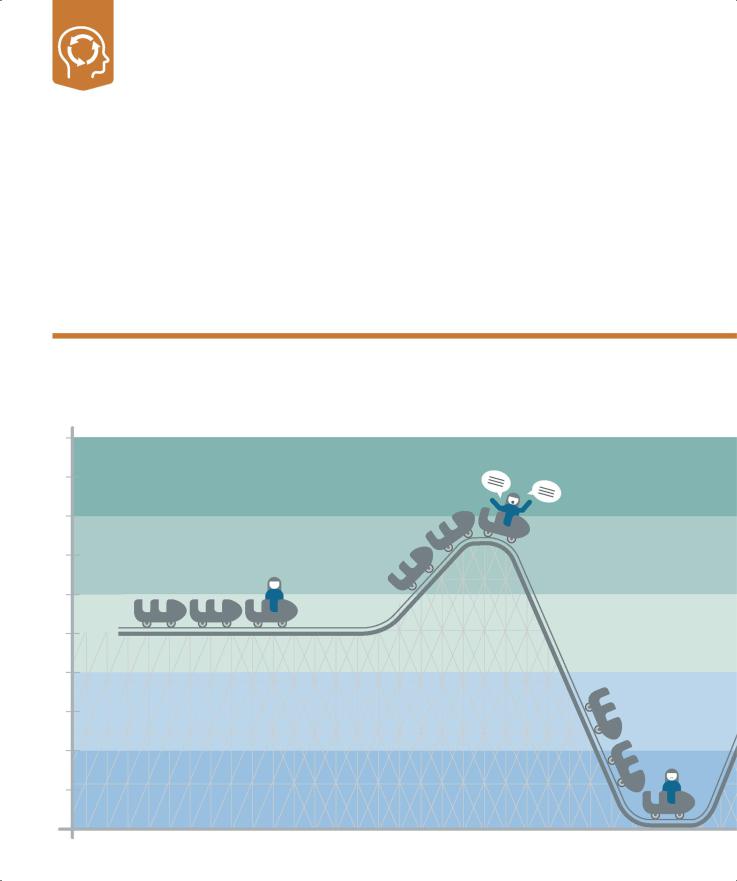
Bipolar disorder
This condition is characterized by extreme swings—highs (mania) and lows (depression)—in a person’s energy and activity levels, which is why it was originally called manic depression.
What is it?
There are four types of bipolar disorder: bipolar 1 is severe mania lasting for more than a week (the person may need hospitalization); bipolar 2 causes
swings between a less severe mania and low mood; cyclothymia features longer-term hypomanic and depressive episodes lasting for up to two years; and unspecified bipolar disorder is a mixture of the three types. During a mood swing an individual can undergo
extreme personality changes, which puts social and personal relationships under severe strain.
The main cause of bipolar is commonly believed to be an imbalance of the chemicals involved in brain function. Known as neurotransmitters, these chemicals include norepinephrine, serotonin, and dopamine, and relay signals between nerve cells (pp.28–29). Genetics also play a role: bipolar disorder runs in families, and it can develop at any age. It is thought that 2 in every 100
Patterns of depression and mania
There are distinct phases to the mood swings of bipolar disorder. The extent and timescale of fluctuations and the way moods manifest themselves and affect personality can vary widely.
10 |
MANIA |
|
|
9 |
|
||
|
|
||
8 |
HYPOMANIA |
|
|
7 |
|
||
|
|
||
6 |
BALANCED/ NORMAL MOOD |
||
5 |
|||
|
|
||
4 |
|
DEPRESSION |
|
3 |
MILD |
||
|
|
||
2 |
DEPRESSION |
|
|
1 |
|
||
|
|
||
BALANCED/NORMAL MOOD
This is a state between episodes in which the person copes with regular daily routines and can plan and predict the consequences of day-to-day actions.
HYPOMANIA
In this form of mania, lasting a few days, an individual can be highly productive and function well. It can precede full mania.
DEPRESSION
The person cannot experience pleasure; has difficulty sleeping; has no appetite; may be delusional; or has hallucinations and disturbed, even suicidal, thoughts.
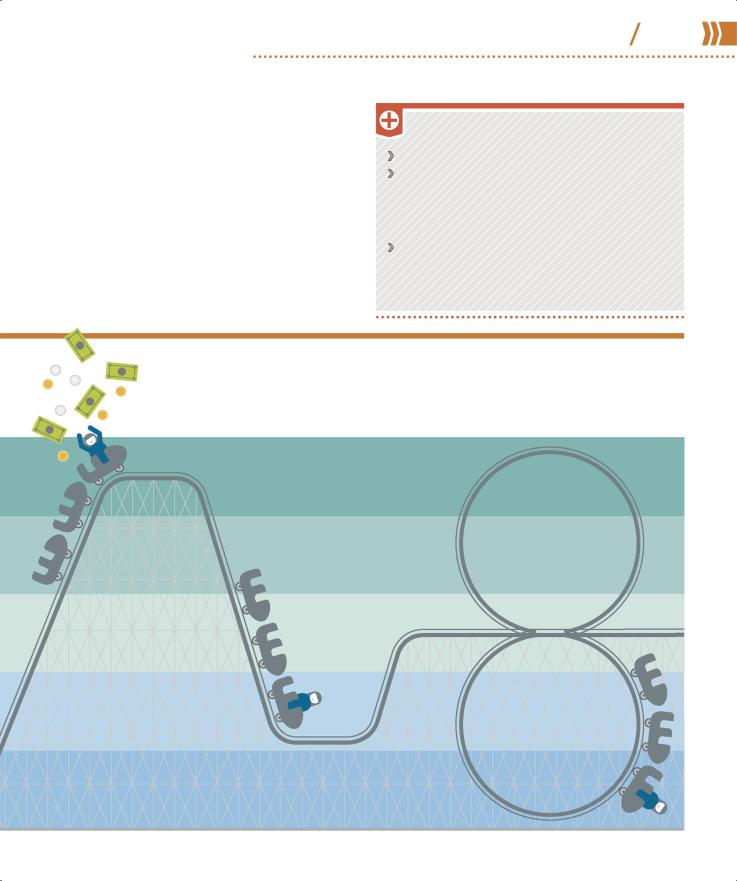
people have an episode at some stage; some have only a couple in their lifetime, whereas others have many. Episodes may be triggered by stress; illness; or hardships in everyday life, such as relationship difficulties or problems with money or work.
How is it diagnosed?
The affected person is assessed by a psychiatrist or clinical psychologist, who asks about the symptoms and when they first occurred. Signals leading up to an episode are explored, too. The doctor also looks to eliminate other conditions that can cause mood swings. The individual is usually treated with medication and lifestyle management techniques.
PSYCHOLOGICAL DISORDERS |
40 41 |
Bipolar disorder |
TREATMENT
Cognitive behavioral therapy (p.125).
Lifestyle management including regular exercise; better diet; sleep routines, which may improve mood regulation; and use of diaries and daily awareness methods, which may help the individual to recognize signs of mood changes.
Mood stabilizers (pp.142–143) taken long term to minimize likelihood of mood swings; dosage often adjusted during episodes of hypomania, mania, or depression.
$
¥
€
“[Bipolar] is a challenge, but it can set you up to be able to do almost anything.”
Carrie Fisher, American actor
£
MANIA
This severe form may last a week or more. Symptoms include hyperactivity; rapid, uninterruptable, and loud speech; risktaking; lack of sleep; and inflated self-image.
MILD DEPRESSION
This is characterized by sadness, low energy, and an inability to concentrate. A person may lack motivation and lose interest in everyday activities.
MIXED STATE
The person suffers from mania at the same time as depression. The individual may, for example, be hyperactive and have depressive symptoms
at the same time.

Perinatal mental illness
Occurring at any time during pregnancy and up to a year after giving birth, perinatal mental illnesses include PPD (postpartum depression), sometimes called postnatal depression, and postpartum psychosis.
What is it?
Feeling tearful or irritable just after giving birth is so common it is dubbed the “baby blues,” but these feelings last for only a couple of weeks. What sets PPD apart from baby blues is the length of time it lasts. It is a longer-term moderate to severe depression that can develop in new mothers (and occasionally fathers) at any time in the year after birth. Symptoms include constant low mood or mood swings, low energy levels, difficulty bonding with the baby, and frightening thoughts. The individual may cry easily and profusely and feel acutely fatigued yet have sleep problems. Feelings of shame and inadequacy, worthlessness, and fear of failure as a parent are common. In severe cases, panic
attacks, self-harm, and thoughts of suicide occur. However, most individuals make a full recovery.
Untreated, PPD may last for many months or longer.
PPD can develop suddenly or slowly, and is usually caused by hormone and lifestyle changes and fatigue. It is not clear why some people develop PPD, but risk factors appear to include difficult childhood experiences, low self-esteem, a lack of support,
and stressful living conditions.
How is it diagnosed?
To determine whether an individual has PPD, a doctor, midwife, or health professional assesses symptoms using an efficient and reliable screening questionnaire such as the Edinburgh Postnatal
85%
of new mothers experience the
“baby blues”
Depression Scale, which rates mood and activity levels over the previous seven days. Other assessment scales are used to assess mental well-being and functioning.
Good clinical judgment is needed when interpreting the results of these questionnaires as new parents are likely to be less active simply as a result of their new responsibilities.
POSTPARTUM PSYCHOSIS
An extremely serious condition, postpartum psychosis (also known as puerperal psychosis) affects 1–2 women per 1,000 births. It
usually occurs in the first few weeks after delivery, but may begin up to six months after birth. Symptoms often develop rapidly and include confusion, high mood, racing thoughts, disorientation, paranoia, hallucinations, delusions, and sleep disturbance. The individual may
also have obsessive thoughts about the baby, and attempt to self-harm or harm the baby. Immediate treatment is needed because of the potentially life-threatening thoughts and behaviors associated with the disorder. Treatment comprises hospitalization (usually in a highly monitored mother-and-baby treatment unit), medication (antidepressants and antipsychotics), and psychotherapy.
TREATMENT
Cognitive and behavioral therapies (pp.122–129) in a group, one-on-one, or as guided self-help; one-on-one counseling.
Lifestyle management, such as talking to partner, friends, and family; resting; regular exercise; and eating healthily and regularly.
Antidepressants (pp.142–143) alone or with psychotherapy.
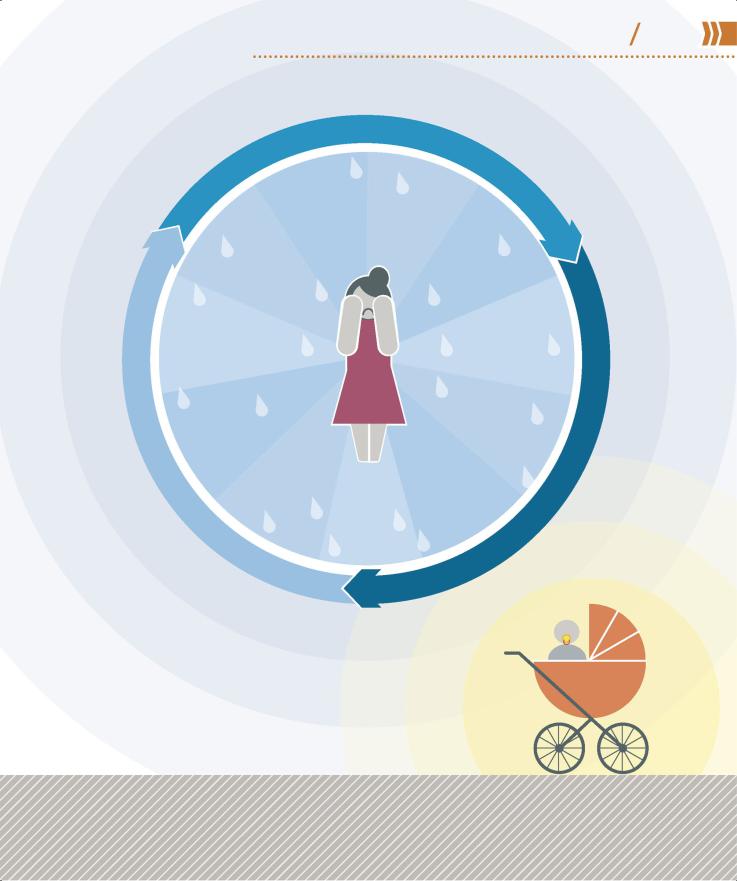
PSYCHOLOGICAL DISORDERS |
42 43 |
Perinatal mental illness |
|
|
r |
|
p |
|
e |
|
|
D |
|
|
es
sion
SLEEP |
|
Inability |
|
sleeping to |
|
|
PATTERNS |
|
sleep |
too |
|
|
much |
|
or |
andIntenseNEGATIVE anger irritability FEELINGS
MOOD |
SWINGS |
followed |
enervation |
|
Elation |
by |
|||
|
|
MOOD |
|
DEPRESSED |
|
or |
|
to |
|
unable |
||
Feeling |
|
cope |
|
|
|
unwilling |
|
|
DIFFICULTY |
BONDING |
FATIGUE |
lethargy |
||||
Not |
feeling |
|
|||||
|
expected |
Ranging |
from |
|
|||
parental love |
for |
|
|
|
|||
|
to |
|
|
||||
|
|
|
|
baby |
exhaustion |
||
|
|
|
|
|
|
|
|
s |
|
|
|
|
|
|
|
|
s |
|
|
and |
|
|
|
|
|
e |
|
|
|
|
|
|
||
n |
CRYING |
crying |
|
|
|
|
|
|
e |
|
|
|
|
|
|
|
|
Excessive |
|
|
|
|
|
|
||
s |
|
tearful |
|
|
|
|
|
|
s |
|
|
|
|
|
|
|
|
l |
feeling |
|
|
|
|
about |
||
|
|
|
|
|
|
|
||
h |
|
|
|
Apprehensive |
|
parent |
||
t |
|
|
|
|
|
|||
|
|
|
|
|
good |
|
||
r |
|
|
|
|
|
|
||
o |
|
FEAR |
|
a |
|
|
|
|
w |
|
being |
|
|
|
|||
|
o |
|
|
|
|
|
|
|
|
f |
|
|
|
|
|
|
|
|
e |
|
|
|
|
|
|
|
|
|
s |
|
|
|
|
|
|
|
|
n |
|
|
|
|
|
|
|
|
e |
|
|
|
|
|
|
|
|
|
S |
|
|
|
|
|
|
WITHDRAWAL |
|||
|
From |
|
|
|
|
and |
|
partner, |
|
|
|
|
|
|
|
|
friends |
family, |
|
|
Loss |
|
|
|
|
APPETITE |
|
|
|
|
foodsappetite |
|
|
|
interestthatenjoyment |
of |
|
|
|
|
|
|
|
|
in |
|
|
|
|
used |
appetite |
|
|
|
|
for |
|
|
|
|
or |
|
|
|
APATHYReducedactivitiesto |
unhealthy |
|
|
|
bring |
|
|
|
|
|
I |
|
s |
|
o |
|
l |
|
a |
|
t |
|
i |
o |
|
n |
|
Range of symptoms
The symptoms of postpartum depression are similar to those of anxiety and general depression. Symptoms can make it difficult to complete day-to-day activities and routines, and can affect an individual’s relationship with their baby, partner, family, and friends.
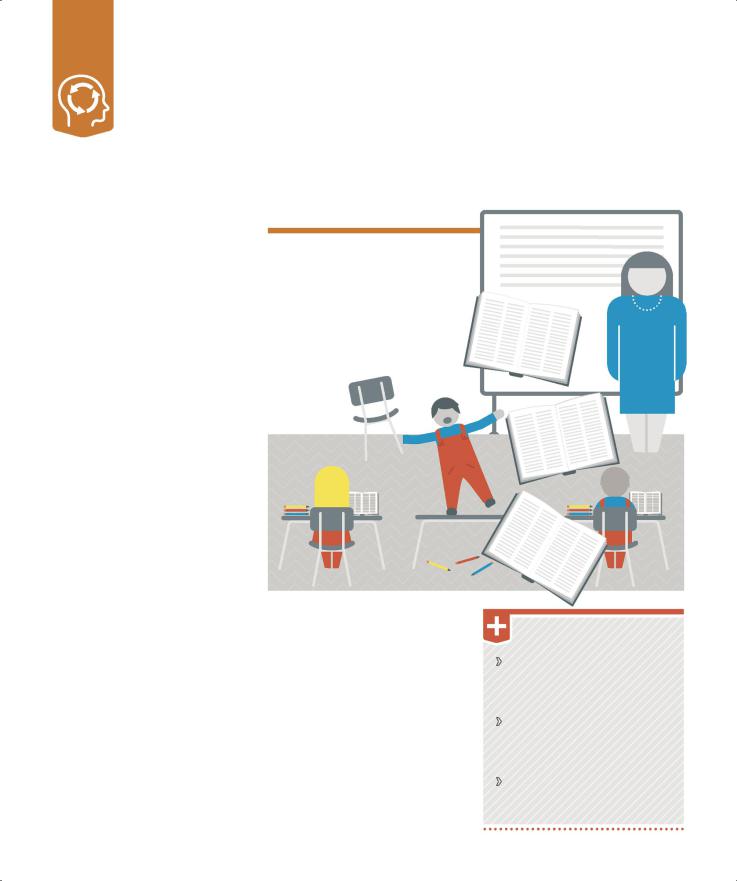
DMDD (disruptive mood dysregulation disorder)
DMDD is a childhood disorder characterized by almost constant anger and irritability combined with regular and severe temper tantrums.
What is it?
DMDD is a recently identified disorder that children with a history of chronic irritability and serious temper outbursts are now recognized as having. The child is sad, bad-tempered, and/or angry almost every day. The outbursts are grossly out of proportion with the situation at hand, occur several times every week, and happen in more than one place (at home, at school, and/or with peers). Strained interactions that occur only between a child and their parents, or a child and their teacher, do
not indicate DMDD.
Disruptive behavior
Children with DMDD regularly have severe temper tantrums, inconsistent with their developmental stage, three or more times a week in at least two different settings.
How is it diagnosed?
For a diagnosis of DMDD, the symptoms must be evident consistently for more than a year, and interfere with a child’s ability to function at home and at school. One cause can be that the child misinterprets other people’s expressions, in which case training in facial-expression-recognition can be offered. Diagnosed children are generally under the age of 10, but not younger than 6 or older than 18. One to 3 percent of children under the age of 10 have symptoms.
Children with DMDD were once identified as having pediatric bipolar disorder, but they do not present with the episodic mania or hypomania of that disorder. They are unlikely to develop bipolar, but are at a higher risk of depression and anxiety
as adults.
2013the year DMDD was recognized
DESTROYS |
|
|
||
things |
|
|
|
|
and/or |
|
|
||
throws |
them |
|
|
|
around |
|
|
||
|
|
|
|
|
room |
|
|
||
|
|
|
ABUSE |
|
SHOUTS |
|
|||
|
atteachers, |
|||
|
peers, |
or |
parents |
|
|
|
|||
|
|
|
||
|
ANGRY AND |
|||
almostIRRITABLE |
|
|||
the |
time |
all |
of |
|
|
|
|||
|
|
|
||
TREATMENT
Psychotherapy (pp.118−141) for both child and family to explore emotions and develop mood management techniques.
Lifestyle management including positive behavior support to establish better communication and minimize outburst triggers.
Antidepressants or antipsychotics (pp.142–143) to support psychotherapy.
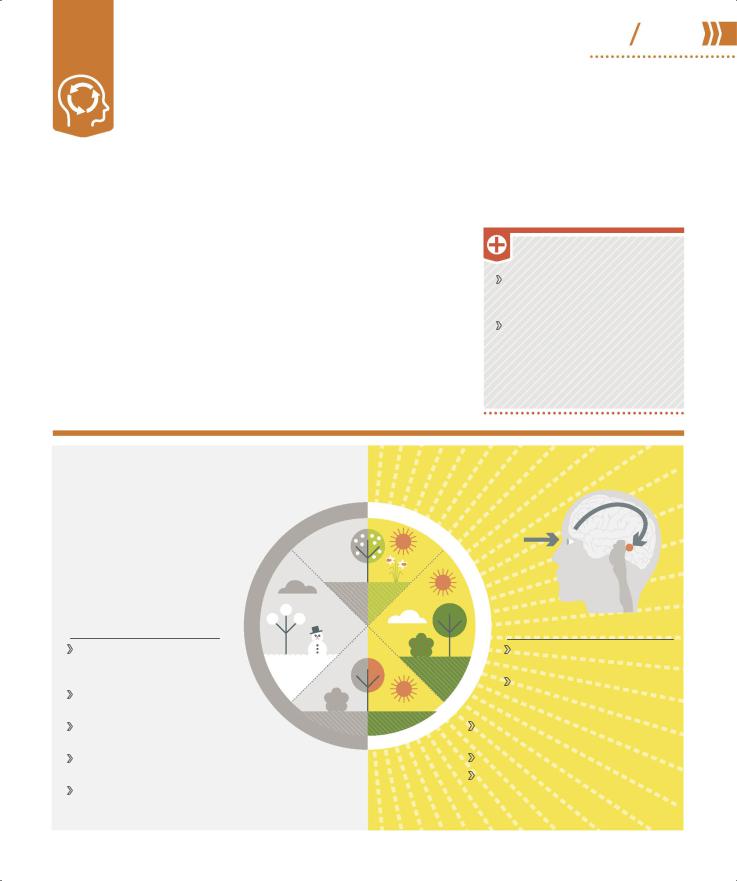
SAD (seasonal 44 45 affective disorder)
SAD is a form of seasonal depression linked to changing levels of light that typically starts in fall as the days shorten. It is also known as “winter depression” or “hibernation state.”
What is it?
The nature and severity of SAD vary from person to person, and for some it can have a significant impact on their day-to-day life. Typically the symptoms come and go with the seasons, and always begin at the same time of year, often in the fall. Symptoms include low mood, a loss of interest in everyday activities, irritability, despair, guilt, and feelings of
Seasonal cause and effect
Sunlight level affects a part of the brain called the hypothalamus by altering the production of two chemicals: melatonin (which controls sleep) and serotonin (which changes mood).
worthlessness. People with SAD lack energy, feel sleepy during the day, sleep for longer than normal at night, and find it hard to get up in the morning. As many as one in three people are affected.
SAD’s seasonal nature can make diagnosis difficult. Psychological assessment looks at a person’s mood, lifestyle, diet, seasonal behavior, thought changes, and family history.
TREATMENT
Psychotherapies, such as cognitive behavioral therapy (p.125) and counseling.
Lifestyle management by improving access to light—sitting near windows when inside, using a sunlight-simulating light bulb, and daily outdoor activity.
|
|
Secretion of melatonin |
|
|
by the pineal gland is |
|
|
triggered by darkness/ |
prin |
|
inhibited by light and |
g |
controlled by the |
|
S |
hypothalamus. |
|
|
|
|
r |
Winter pattern |
e |
t |
|
|
n |
Melatonin increases |
i |
W |
|
so person is tired and wants |
|
to sleep. |
|
Serotonin production drops, |
|
causing person to feel low. |
|
Desire to stay in bed and sleep can lead to reduced social contact.
Craving carbohydrates can cause overeating and weight gain.
Constant daytime fatigue affects work and family life.
Fall
S |
|
u |
|
m |
|
m |
Summer pattern |
e |
Melatonin drops so person |
r |
|
|
has more energy. |
|
Serotonin production |
|
increases, improving mood |
|
and outlook. |
Sleep is good, but not excessive, so person has more energy.
Diet improves as cravings subside.
Improved energy results in increased activity and more social contact.

Panic disorder
Panic attacks are an exaggerated reaction to the body’s normal response to fear or excitement. With panic disorder, a person regularly experiences such attacks for no obvious reason.
What is it?
The normal reaction to fear or excitement causes the body to produce the hormone adrenaline to prepare for “fight or flight” from the source of fear. If a person has a panic attack, apparently normal thoughts or images trigger the brain’s fight-or-flight center, resulting in adrenaline racing
around the body causing symptoms such as sweating, increased heart rate, and hyperventilation. Attacks last about 20 minutes and can be very uncomfortable.
The individual may misinterpret these symptoms, saying they feel as if they are having a heart attack or even dying. The fear can further activate the brain’s threat center so more adrenaline is produced, worsening symptoms.
Individuals who have recurring panic attacks can fear the next one so much that they live in a constant state of “fear of fear.” Attacks may, for example, be set off by fear of being in a crowd or a small space,
but often they are triggered by internal sensations that have nothing to do with the outside world. As a result, everyday tasks can become difficult and social situations daunting. Those with panic disorder may avoid certain places or activities, so the problem persists because the person can never “disconfirm” their fear.
What are the causes?
One in 10 people suffer from occasional panic attacks; panic disorder is less common.
Traumatic life experiences, such as a bereavement, can trigger the disorder. Having a close family member with panic disorder is thought to increase the risk of developing it. Environmental conditions such as high carbon dioxide levels may also cause
attacks. Some illnesses, for example an overactive thyroid, can produce symptoms similar to panic disorder, and a doctor will rule out such illnesses before making a diagnosis.
k c a t t a r e h t o
n A
TREATMENT
Cognitive behavioral therapy
(p.125) to identify triggers, prevent avoidance behavior, and learn to disprove feared outcomes.
Support groups to meet others with the disorder and get advice.
Selective serotonin reuptake inhibitors (SSRIs) (pp.142–143).
2%
of people are affected by panic disorder
|
|
|
|
r |
|
|
|
a |
|
|
|
e |
|
|
|
f |
|
|
|
e |
|
|
|
|
r |
|
|
|
|
o |
|
|
|
|
M |
|
|
|
|
A n x i e t ybuildsup
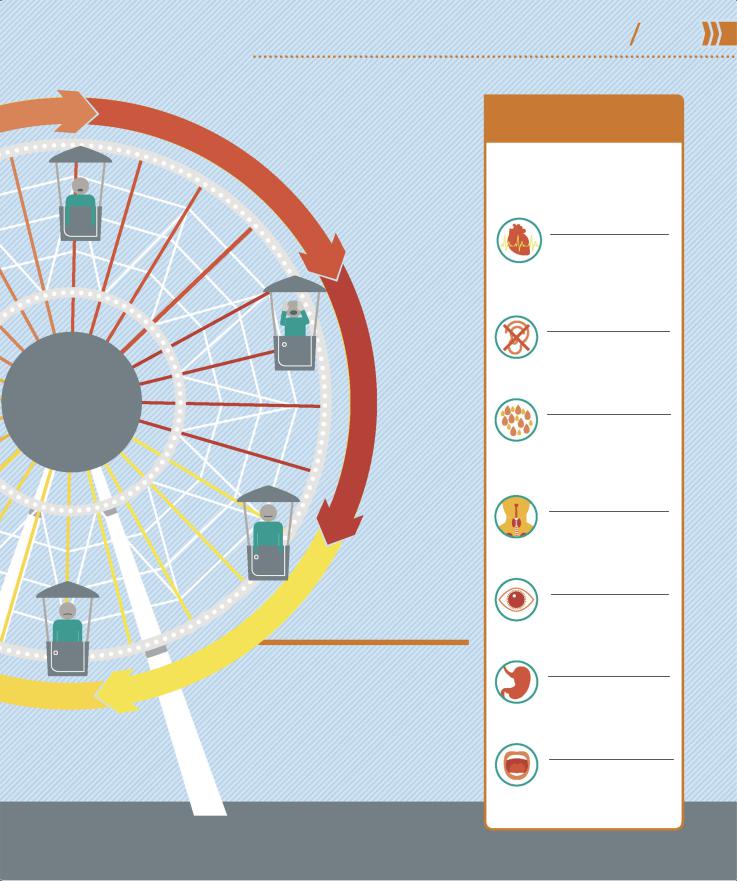
The panic cycle
PSYCHOLOGICAL DISORDERS |
46 47 |
Panic disorder |
Anxi et y
P a n i c
a t t a c k
|
|
|
|
|
|
|
|
|
|
k |
|
|
|
|
|
|
|
|
|
c |
|
|
|
|
|
|
|
|
|
a |
|
|
|
|
|
|
|
|
|
t |
|
|
|
|
|
|
|
|
|
|
t |
|
|
|
|
|
|
|
|
|
|
a |
|
|
|
|
|
|
|
|
|
r |
|
|
|
|
|
|
|
|
|
|
e |
|
|
|
|
|
|
|
|
|
|
h |
|
|
|
|
|
|
|
|
|
|
t |
|
|
|
|
|
|
|
|
|
|
o |
|
|
|
|
|
|
|
|
|
n |
|
|
|
|
|
|
|
|
|
a |
|
|
|
|
|
|
|
|
|
f |
|
|
|
|
|
|
|
Fe |
|
o |
|
|
Constant cycle of |
|||||
r |
|
|
|
|||||||
a |
|
|
|
|
|
|
|
|
|
|
anxiety and fear
A person perceives a threat and starts to panic. The physical symptoms develop, worsening the anxiety and therefore the symptoms, which in turn increase the likelihood of a repeat attack.
SYMPTOMS OF A PANIC ATTACK
The symptoms result from the action of the autonomic nervous system—the part not under conscious control (pp.32−33).
Increased heart rate
Adrenaline causes the heart to pump faster to
move blood containing oxygen to where it is needed. This can result in chest pains.
Feeling faint
Breathing is faster and shallower to increase oxygen, causing hyperventilation
and lightheadedness.
Sweating and pallor
Sweating increases to cool the body. The
person may also become pale as blood is diverted to where it is needed most.
Choking sensation
Faster breathing feels like choking—oxygen
level rises but not enough carbon dioxide is exhaled.
Dilated pupils
The pupil (black part of the eye) becomes
dilated to let in more light, making it easier to see to escape.
Slowed digestion
As digestion is not crucial for “flight,” it slows. The
sphincters (valves) relax, which makes the sufferer feel nauseous.
Dry mouth
The mouth can feel very dry as body fluids are
concentrated in the parts of the body where they are most needed.

Specific phobias
A phobia is a type of anxiety disorder. Specific phobias manifest themselves when a person anticipates contact with, or is exposed to, the object, situation, or event they fear.
What are they?
Specific, simple phobias (as opposed to the complex ones, agoraphobia and claustrophobia, pp.50–51) are the most common psychological disorders in children and adults. A phobia is much more than fear and arises when a person develops an exaggerated or unrealistic sense of danger about a situation or an object. The fear may not make any sense, but the individual feels powerless to stop it. Anticipated or actual exposure (even to an image) can cause extreme anxiety or a panic attack. Symptoms include rapid heart rate, breathing difficulties, and a feeling of being out of control.
A combination of genetics; brain chemistry; and other biological, psychological, and environmental
TREATMENT
Cognitive behavioral therapy
(p.125) to overcome a phobia using a system of graded steps to work toward the goal of confronting the feared object or situation without fear; anxiety management techniques to master each step.
Mindfulness to raise tolerance of anxiety and of thoughts or images associated with the distress.
Anti-anxiety medication or antidepressants (pp.142–143) alongside therapy if the phobia is impairing day-to-day living.
factors can give rise to a phobia. It can often be traced back to a frightening event or stressful
situation a person either witnessed or was involved in during early childhood. A child can also “learn” a phobia through seeing other family members demonstrate phobic behavior.
Specific phobias often develop during childhood or adolescence and may become less severe with age. They can also be associated with other psychological conditions such as depression (pp.38–39), obsessive compulsive disorder (pp.56–57), and post-traumatic stress disorder (p.62).
How are they diagnosed?
Many affected individuals are fully aware of their phobia, so a formal diagnosis is not necessary and they do not need treatment—avoiding the object of their fear is enough to control the problem. However, in some people habitual avoidance of a feared object can also maintain or worsen the phobia, and seriously impact aspects of their lives. A GP can refer them to a specialist with expertise in behavioral therapy.
SPECIFIC PHOBIAS are very treatable with gradual, guided exposure to the feared object or situation.
8.7%
of adult Americans are affected by a specific phobia
Types of specific phobia
There is a wide variety of objects or situations that can trigger a phobia. Specific, so-called “simple,” phobias fall into five groups: blood-injection- injury, natural environment, situational, animal, and “other” types. With the exception of the first type, specific phobias are two to three times more common in females than males.
